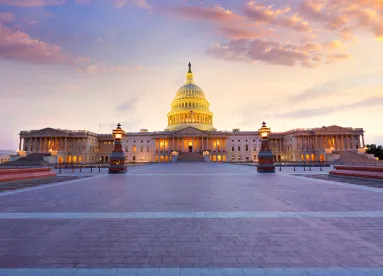With the enactment of the PFAS Act of 2019 and related provisions in December, opposing forces in Congress came together to force regulatory action on several different aspects of per- and poly-fluorinated substances (PFAS). Issues on which agreement was not reached are now before the Senate in House-passed legislation. While the PFAS debate continues in Congress, federal agencies are now tasked with multiple obligations related to PFAS. Companies that handle PFAS will have added PFAS reporting obligations under both the Toxics Release Inventory and the Toxic Substances Control Act.
The PFAS Act of 2019 is title LXXIII of the massive National Defense Authorization Act for Fiscal Year 2020 (NDAA), Public Law 116-92 (Dec. 20, 2019). This alert summarizes its six subtitles, as well as other PFAS provisions in the NDAA related to the Department of Defense (DOD). It then provides a preview of future legislative developments.
PFAS Act of 2019 Provisions
Subtitle A – Drinking Water Monitoring
EPA must include certain PFAS and classes of PFAS in the fifth Unregulated Contaminants Monitoring Rule (UCMR 5), expected later this year. EPA’s PFAS Action Plan (Feb. 2019) had called for EPA to take this action, but Subtitle A requires it to do so. EPA had included six PFAS in UCMR 3.
The PFAS to be included are all PFAS and classes of PFAS for which EPA has a validated test method for drinking water and that are not subject to a national primary drinking water standard under the Safe Drinking Water Act (SDWA). EPA has a validated test method for 18 PFAS, which it adopted in 2009 and expanded in 2018, EPA Method 537.1. The PFAS Action Plan had predicted additional test methods in 2019, but this did not occur.
The SDWA limits the number of unregulated contaminants that may be included in each UCMR to 30, but the NDAA excludes the listed PFAS from that limit.
Subtitle A also provides grant eligibility through the Drinking Water State Revolving Funds to address PFAS.
Subtitle B – Toxics Release Inventory
EPA’s PFAS Action Plan had set as a long-term action exploring data availability for listing some PFAS as toxic chemicals for purposes of the Toxics Release Inventory (TRI) under section 313 of the Emergency Planning and Community Right-to-Know Act of 1986 (EPCRA). EPA had begun that lengthy process with an advance notice of proposed rulemaking, published on December 4, 2019.
The NDAA disrupted this process later that month. By its terms, Subtitle B automatically added multiple PFAS to the TRI list as of January 1, 2020, and others will be automatically added as certain milestones are reached. EPA posted a list of 160 PFAS that were added as of January 1, 2020. The reporting threshold for all of the chemicals is set at 100 pounds unless revised by EPA within the next 5 years. Reporting on these 160 PFAS will be due by July 1, 2021.
Future automatic additions to the TRI list (as of January 1 of the following year) are mandated whenever:
-
EPA finalizes a toxicity value for a PFAS. (EPA has a provisional peer-reviewed toxicity value for PFBS, adopted in 2014.) Toxicity values are used in risk assessments under the Comprehensive Environmental Response, Compensation, and Liability Act (CERCLA).
-
EPA finalizes a significant new use rule (SNUR) under the Toxic Substances Control Act (TSCA) for a PFAS or class of PFAS.
-
EPA adds a PFAS or class of PFAS to an existing SNUR.
-
EPA designates a PFAS or class of PFAS as active on the TSCA Inventory.
In addition, over the next two years, EPA must determine whether certain listed PFAS meet any of the listing criteria in section 313. If so, EPA must add them to the TRI list within two years of making that determination.
These additions to the TRI list are subject to the provision that, if any PFAS chemical identity is claimed confidential, the PFAS is not added to the list until EPA reviews a substantiation of that claim. If EPA upholds the claim, that PFAS must be added to the list in a manner that does not disclose its identity (such as through a generic name).
Subtitle C – USGS Performance Standard and Sampling
Subtitle C directs the United States Geological Survey (USGS) to coordinate with EPA to develop an appropriate testing methodology for PFAS that is “as sensitive as is feasible and practicable,” with the ability to detect as many “highly fluorinated compounds” as possible. Highly fluorinated compounds are defined to mean PFAS with at least one fully fluorinated carbon atom. USGS must also develop quality assurance and quality control measures to ensure accurate sampling and testing, as well as a training program.
In addition, USGS must carry out nationwide sampling for PFAS. The nationwide sampling program must start with drinking water near locations with known or suspected sources of PFAS. Later stages of sampling will be based on an evaluation by USGS in consultation with the states and EPA to determine where sampling should occur, with an emphasis on direct human exposure through drinking water. The results of the sampling must be sent to EPA and, upon request, the states. In addition, USGS must prepare a report and submit it to certain committees and members of Congress.
EPA’s PFAS Action Plan called for EPA to collaborate with USGS, the Army Corps of Engineers, and universities to lead the science of PFAS.
Subtitle D – Emerging Contaminants
Subtitle D encourages research into “emerging contaminants,” defined broadly to include any physical, chemical, biological, or radiological substance or matter in water for which there is no national primary drinking water standard and that may have an adverse impact on the health of individuals. It mandates several actions to improve the level of technical understanding as well as support for states.
First, EPA, in collaboration with states and other stakeholders, must establish a strategic plan for improving existing federal efforts to identify, monitor, and assist in the development of treatment systems for emerging contaminants and to assist states in responding to human health risks posed by such contaminants.
Second, Subtitle D requires the establishment of a Working Group within 180 days of enactment to coordinate federal activities identifying and analyzing public health effects of emerging contaminants in drinking water. The Working Group will be comprised of representatives from several federal entities, including EPA, the National Institutes of Health, the Centers for Disease Control and Prevention, the Agency for Toxic Substances and Disease Registry, USGS, and others in the discretion of EPA.
Third, it requires the Director of the Office of Science and Technology Policy to establish the National Emerging Contaminant Research Initiative within 180 days of enactment. The goal will be improving the identification, analysis, monitoring, and treatment methods for emerging contaminants, including identifying priority emerging contaminants for research emphasis. Within one year after establishing the research initiative, involved agencies must issue solicitations for grant proposals for research projects consistent with that strategy.
Finally, Subtitle D requires EPA to study the actions it can take to increase technical assistance and support to states with respect to drinking water in emerging contaminants and issue a report to Congress within 18 months. Based on the findings in that report, EPA must develop a program to provide technical assistance to states within three years of enactment. When evaluating applications submitted by states seeking assistance, EPA must give priority to states with affected areas, primarily in financially distressed communities. Emergency assistance may be provided without application. EPA must also establish and maintain a database of available resources developed to assist states with testing for emerging contaminants and make it available to states and stakeholder groups with a scientific or material interest, such as drinking water utilities. The database must be searchable and available through the EPA website.
Subtitle E – TSCA Provisions
Subtitle E requires EPA to take two actions regarding TSCA – finalize amendments to two SNURs for certain PFAS substances by June 22, 2020, and issue a final rule by January 1, 2023, requiring manufacturers of PFAS to report detailed information about their PFAS.
The two PFAS SNURs and the effect of Subtitle E on EPA’s timetable for finalizing them are discussed in another Beveridge & Diamond alert, available here.
Subtitle E also amends TSCA § 8(a) so as to direct EPA to issue a final rule that would require each person who has manufactured a PFAS in any year since 2011 to submit a report that includes, for each year since 2011, detailed information on that PFAS. EPA must issue the rule by January 1, 2023.
The information that a PFAS manufacturer must provide includes, for each such PFAS:
-
Its common or trade name, chemical identity, and molecular structure.
-
Its categories or proposed categories of use.
-
The total amount manufactured or processed, reasonable estimates of the total amount to be manufactured or processed, the amount manufactured or processed for each of its categories of use, and reasonable estimates of the amount to be manufactured or processed for each of its categories of use or proposed categories of use.
-
A description of the byproducts resulting from its manufacture, processing, use, or disposal.
-
All existing information concerning its environmental and health effects.
-
The number of individuals exposed to it, and reasonable estimates of the number who will be exposed to it in their places of employment and the duration of such exposure.
-
The manner or method of its disposal.
Subtitle F – Guidance on Disposal; Research
EPA must publish interim guidance on the destruction and disposal of PFAS within one year of enactment. The guidance must address aqueous film-forming foam (AFFF), soil and biosolids, textiles (other than consumer goods) treated with PFAS, spent water treatment equipment, landfill leachate containing PFAS, and waste streams from facilities manufacturing or using PFAS. EPA must publish revisions at least every three years.
EPA’s Office of Research and Development must examine the effects of PFAS on human health and the environment and make that information public It must also develop a process for prioritizing PFAS and classes of PFAS for additional research. A total of $15 million per year for each of the next five years is authorized for appropriation for this research.
DOD-Related PFAS Provisions of the NDAA
The National Defense Authorization Act includes several PFAS provisions in Title III, related to DOD operations and maintenance at military bases. AFFF containing PFAS, used for putting out fires, is the subject of several provisions. These include prohibiting the uncontrolled release of AFFF containing PFAS, with limited exceptions for emergency response as well as incineration requirements for the disposal of AFFF that must meet the Resource Conservation and Recovery Act (RCRA). The use of PFAS AFFF must be phased out by October 1, 2024, and the use of PFAS in packaging for meals ready-to-eat (MREs) must end by October 1, 2021. There are also provisions for information sharing with municipal drinking water utilities located adjacent to military installations.
Additional PFAS Legislation
During the conference to reconcile the House and Senate versions of the NDAA, the House managers pushed for additional PFAS provisions, but the two sides did not reach agreement on those provisions. On January 10, 2020, the House passed a revised H.R. 535, the PFAS Action Act of 2019, with the votes of 24 Republicans, and sent it to the Senate for its consideration. Senate passage is probably unlikely, particularly in light of the rejection by Senate conferees on the NDAA of some of these provisions.
As revised, H.R. 535 would require a number of regulatory actions on PFAS, including:
-
A requirement that EPA designate PFOA, PFOS, and their salts as hazardous substances under CERCLA § 102(a) within one year of enactment, and determine within five years of enactment whether to designate additional PFAS as hazardous substances.
-
An amendment to TSCA § 4 directing EPA to adopt a rule requiring comprehensive toxicity testing on all PFAS, with a proposed test rule due six months after enactment and a final rule due two years after enactment.
-
An amendment to TSCA § 5 eliminating exemptions for PFAS (such as those for R&D, impurities, and the low-volume exemption).
-
An amendment to TSCA § 5 providing that, for five years after enactment, all PFAS that are the subject of premanufacture notices or significant new use notices are deemed to present an unreasonable risk. EPA would be required to issue orders to prohibit all manufacture, processing, and distribution of those PFAS.
-
An amendment to SDWA § 1412(b) directing EPA to promulgate a national primary drinking water regulation for PFAS (including at last PFOA and PFOS) within two years of enactment. It would also require EPA to publish a health advisory for a PFAS not subject to a national primary drinking water regulation within one year of a finalized PFAS toxicity value or effective quality control and testing procedure for a PFAS, whichever is later.
-
A provision that EPA may not impose a financial penalty for violation of a PFAS national primary drinking water regulation until five years after its adoption.
-
An amendment to the SDWA requiring EPA to establish a program to award grants to affected community water systems.
-
A requirement that EPA adopt a final rule adding PFOA, PFOS, and their salts to the list of hazardous air pollutants under the Clean Air Act § 112(b) within six months of enactment, and to determine within five years of enactment whether to issue final rules adding other PFAS to that list.
-
An amendment of RCRA § 3004 to prohibit unsafe incineration of PFAS.
-
A requirement that EPA revise the Safer Choice Standard of the Safer Choice Program within one year of enactment to identify requirements for certain consumer products to meet to be labeled with a Safer Choice label, including a requirement that they not contain any PFAS.
-
A requirement that EPA issue guidance on minimizing the use of AFFF and related equipment containing PFAS within one year of enactment.
-
A requirement that EPA investigate methods and means to prevent contamination of surface waters by GenX.
-
A prohibition of introducing PFAS pollutants to a treatment works under the Federal Water Pollution Control Act (FWPCA) without first notifying the treatment works of the identity and quantity of each PFAS; whether the PFAS is susceptible to treatment by the treatment works; and whether the PFAS would interfere with the treatment works.
-
A requirement that EPA establish a website containing information on the testing of household well water within one year of enactment.
-
A requirement that EPA develop a risk-communication strategy to inform the public about potential hazards of PFAS.
-
A requirement that EPA publish a plan under FWPCA § 304(m) by September 30, 2021, that contains the results of a review of the introduction into treatment works or discharge of PFAS from categories of point sources (other than publicly owned treatment works). Based on that results of that review, EPA would be required to initiate as soon as practicable the process for adding certain PFAS to the list of toxic pollutants under FWPCA § 307(a), and within two years of publication of the plan to publish human health water quality criteria for other PFAS. EPA would also be required to adopt human health water quality criteria for PFOA, PFOS, and their salts within two years of enactment for each priority industry category, and to adopt a final rule within four years of enactment establishing effluent limitations and pretreatment standards for those PFAS for each priority industry category.
The White House announced on January 7, 2020, that it strongly opposes H.R. 535 and that President Trump’s senior advisors may recommend the bill be vetoed if passed by both Houses.







 />i
/>i

